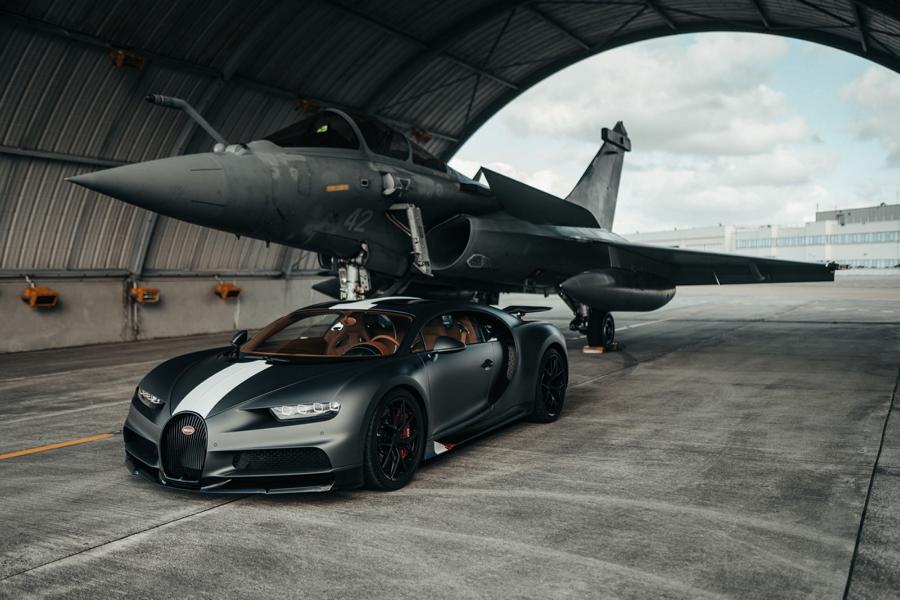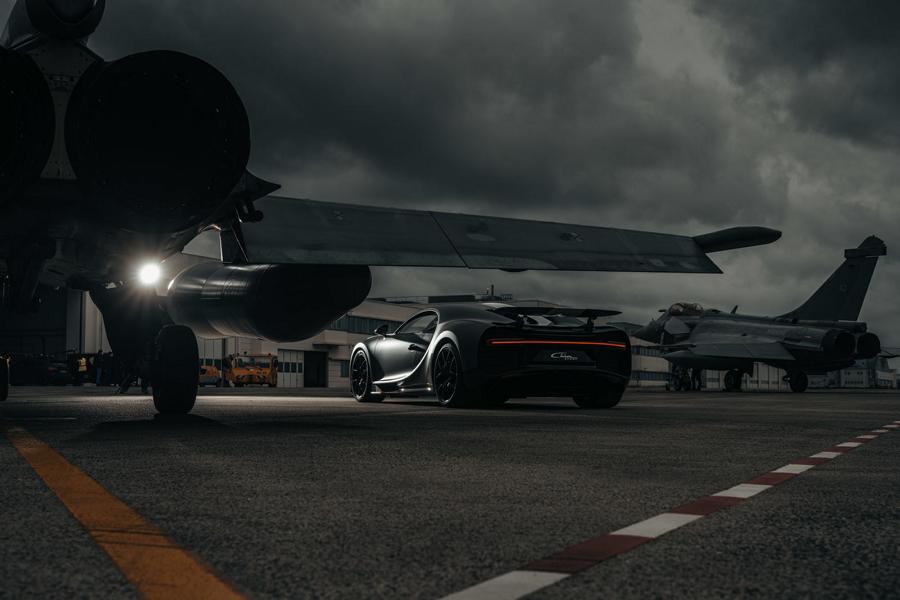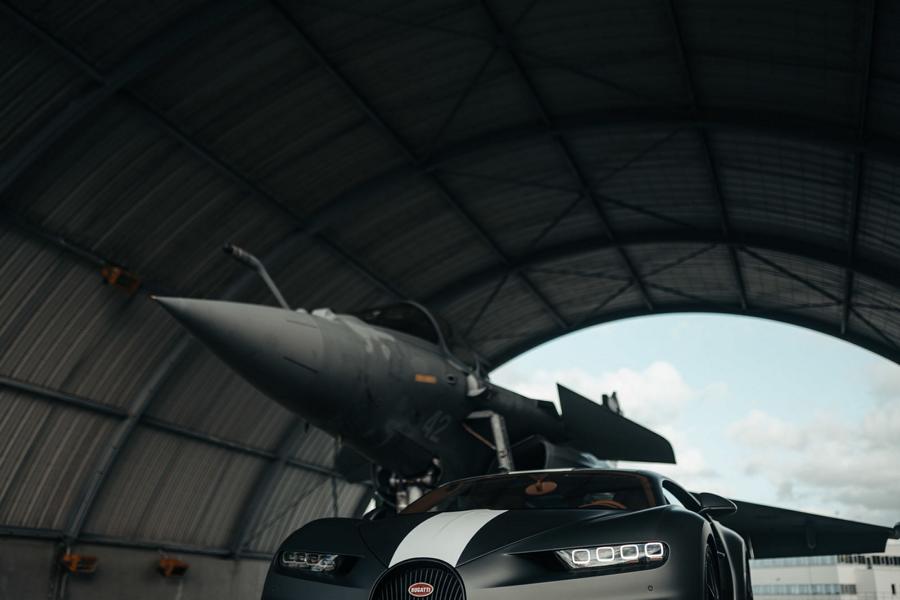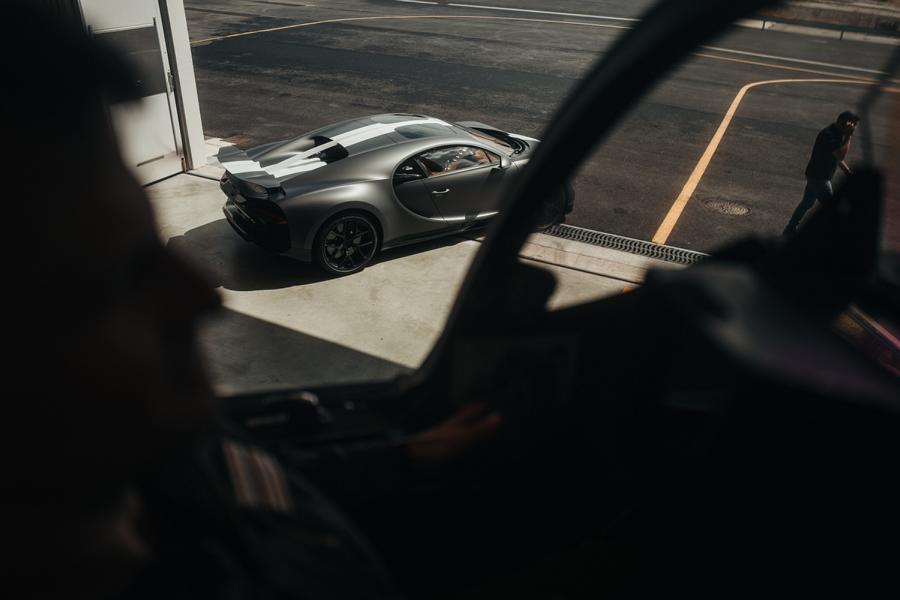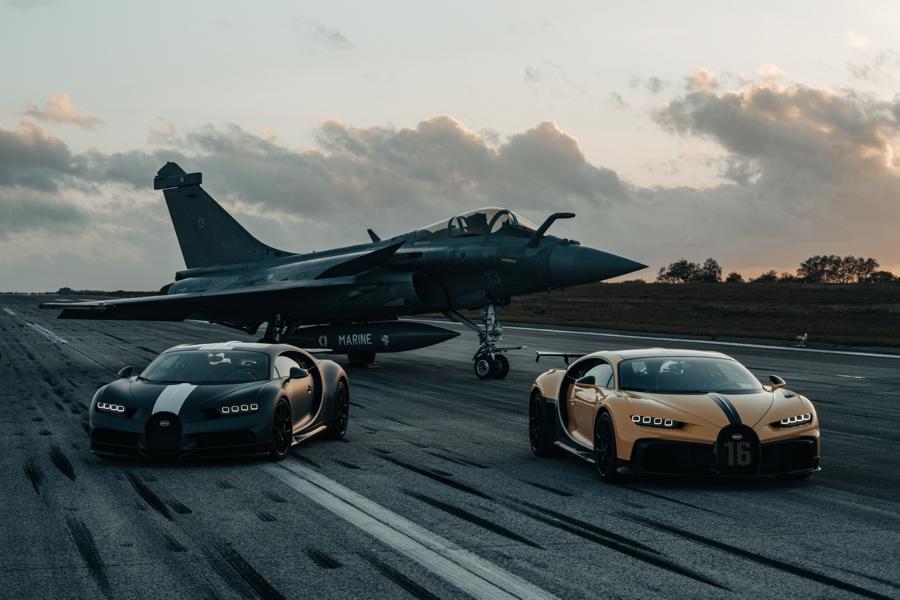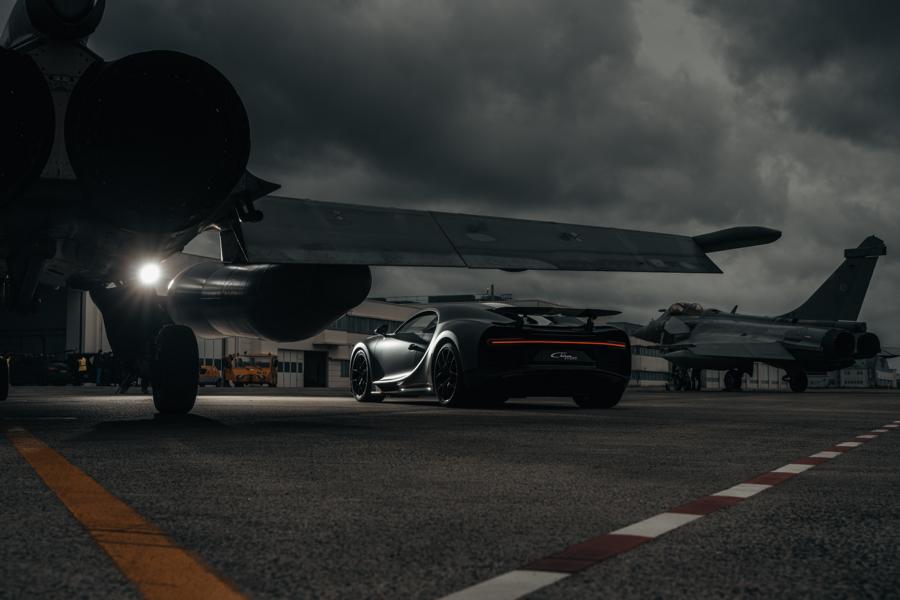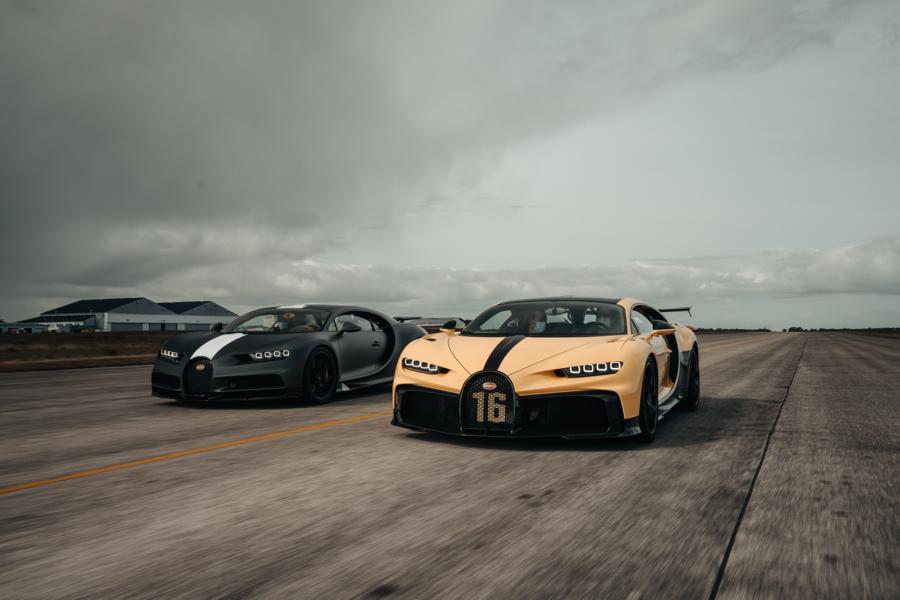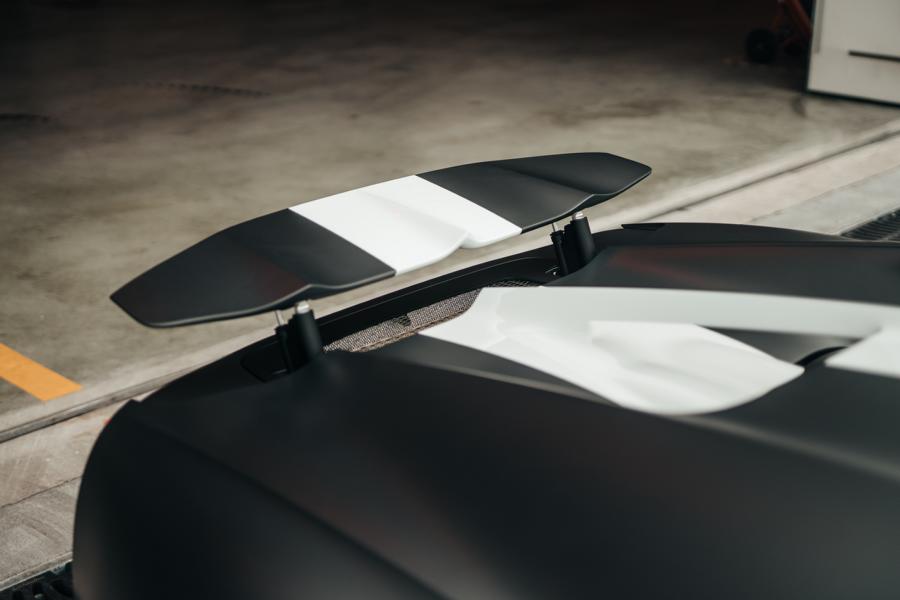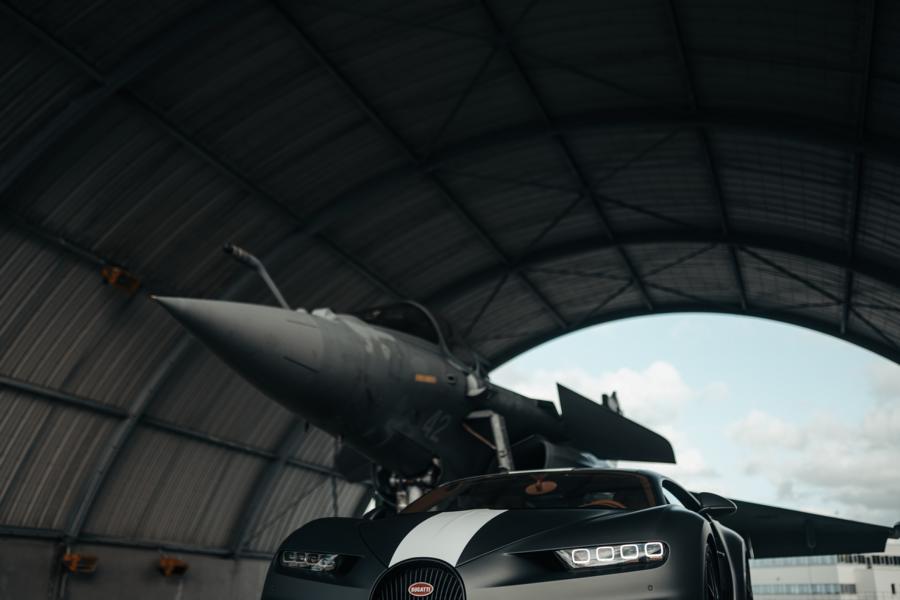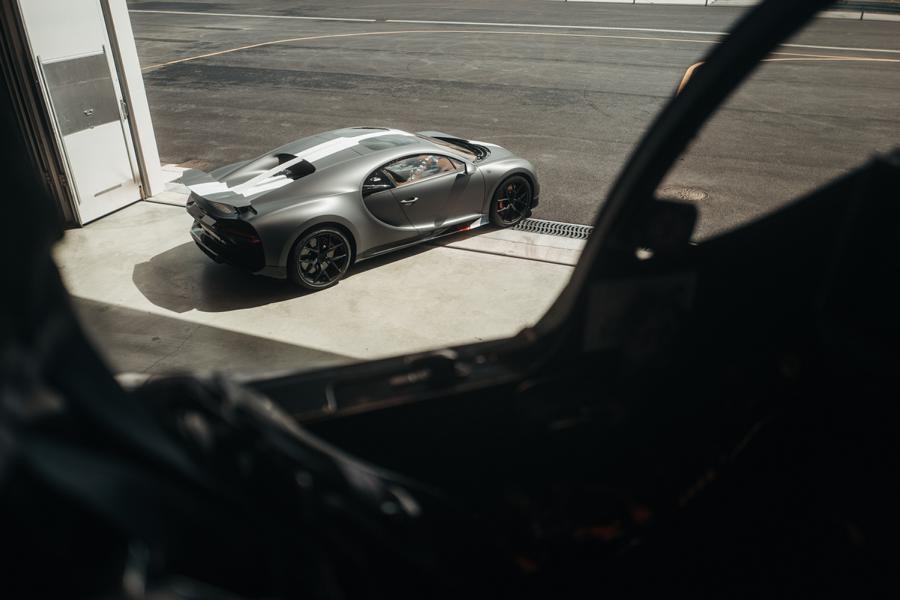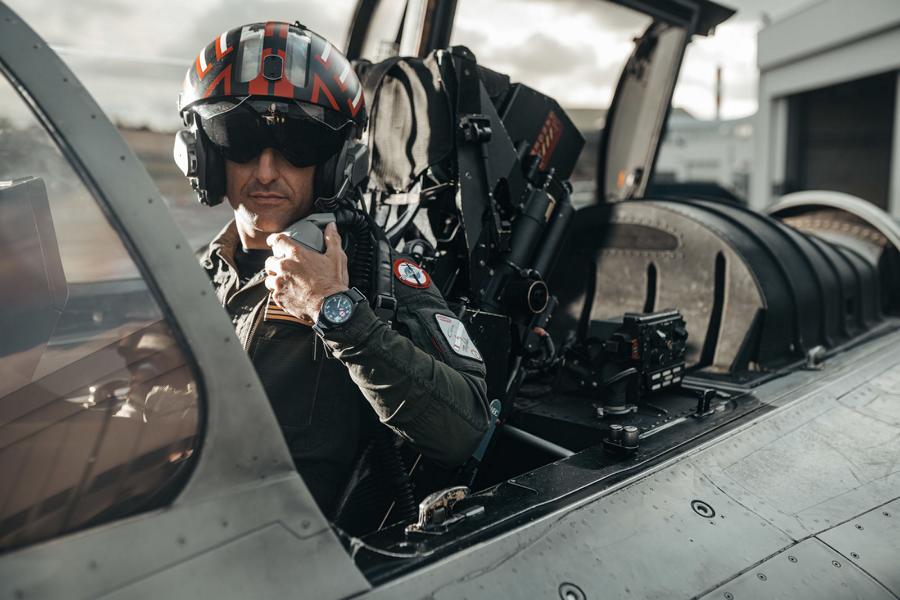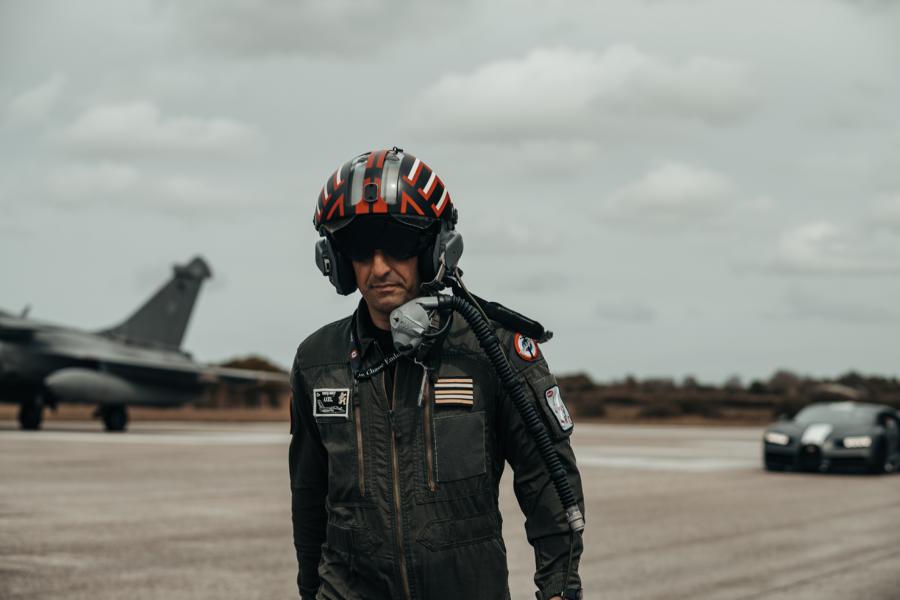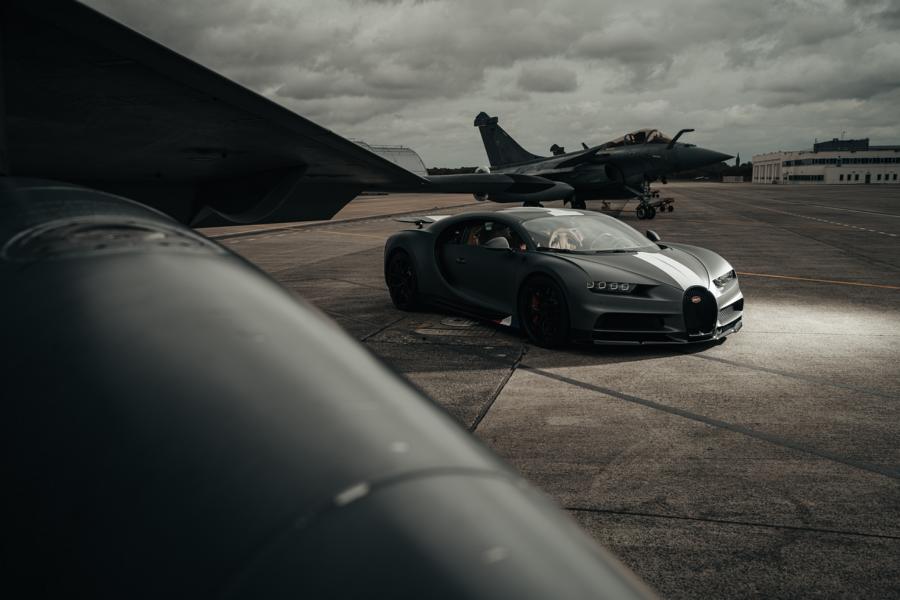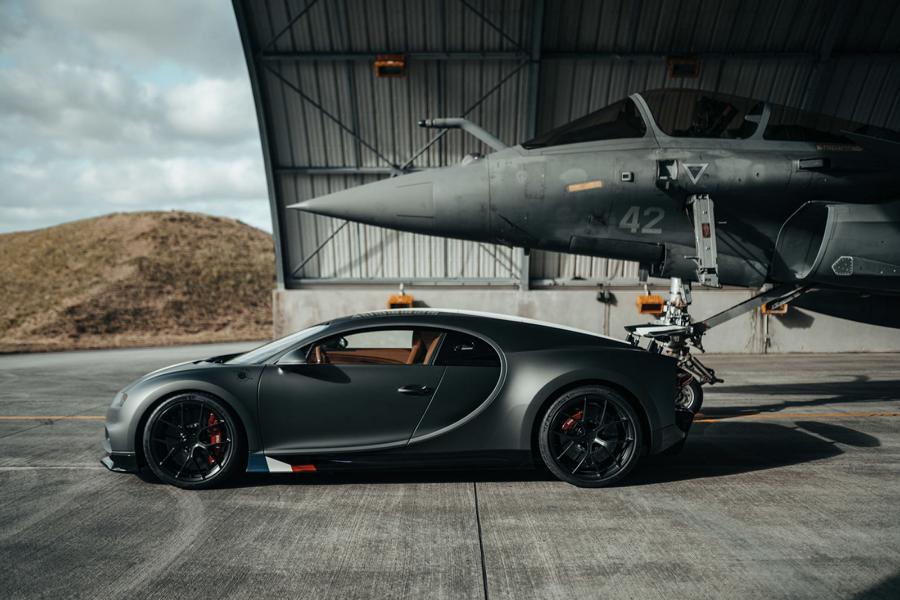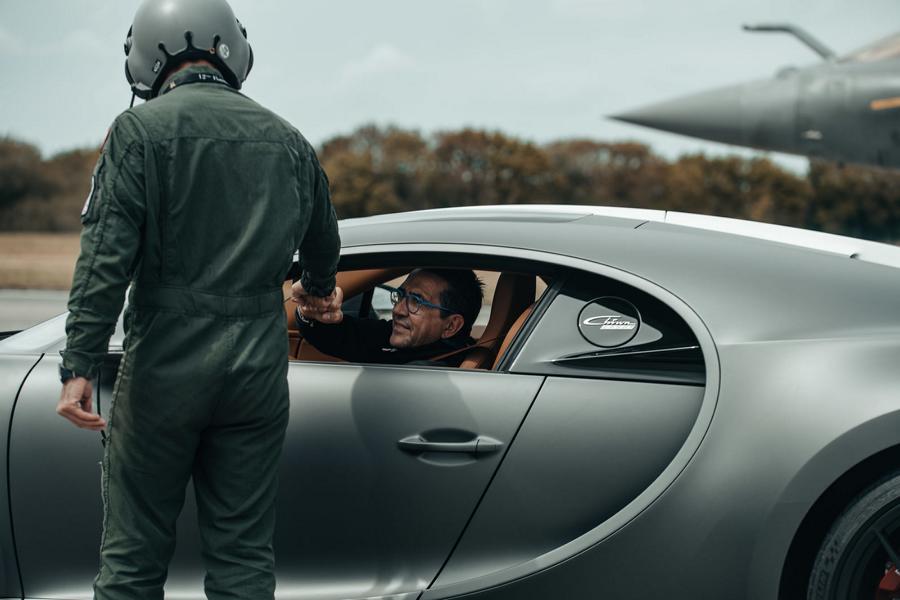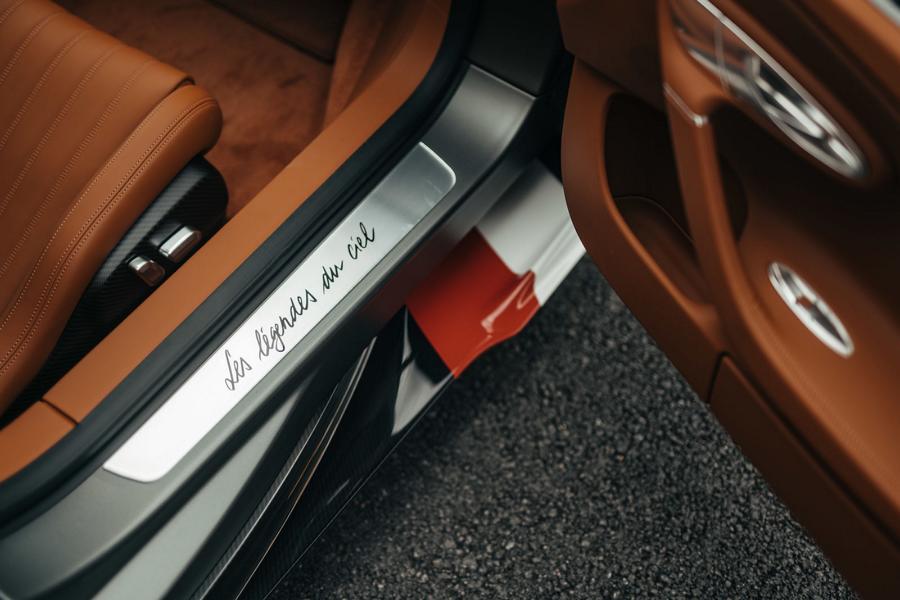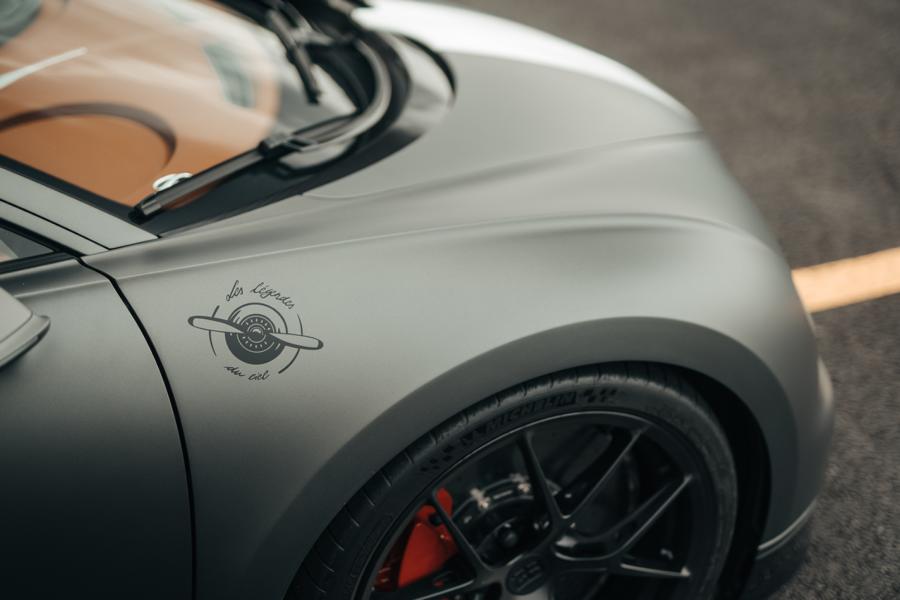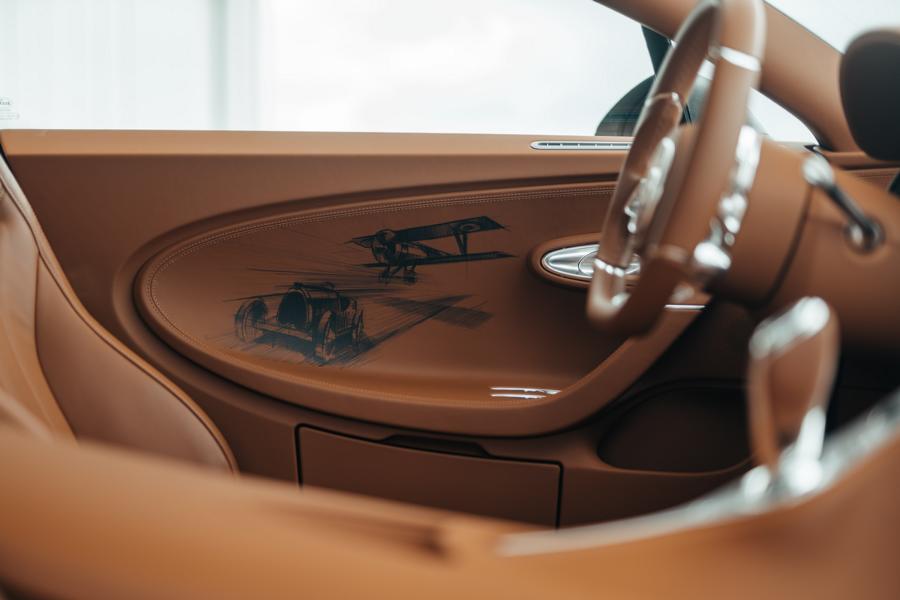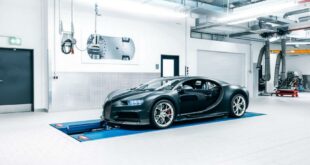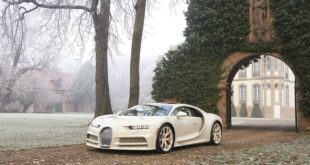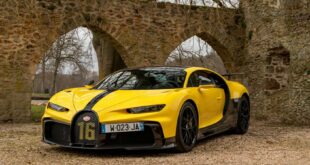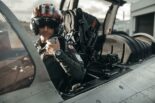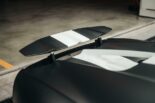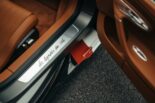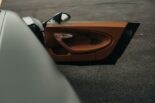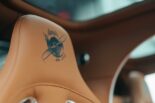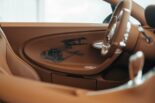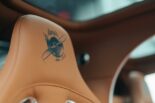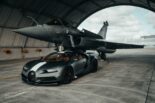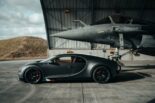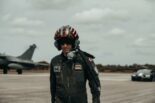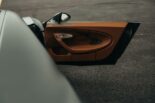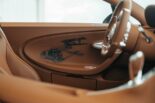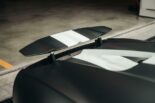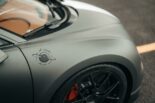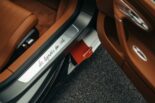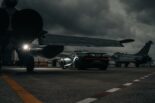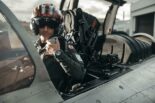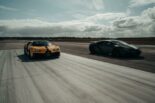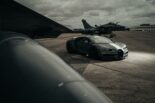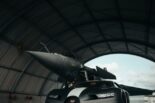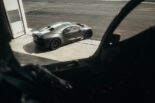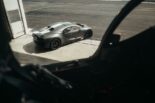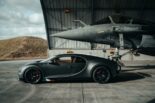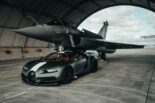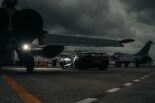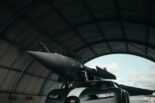Photo credit: Bugatti
The two pilots look ahead with great concentration and wait for the start signal. The tricolor goes down and a moment later the asphalt vibrates. The two start side by side. A quick look into the horizon and both pilots give full throttle. Tires on smooth tar, two engines ignite their afterburners, light up the black ground of the runway. The machines are booming - and after a few seconds have disappeared from view.
Rendezvous of two superlatives
Start of an extraordinary comparison in Landivisiau: Bugatti Chiron Sport1 against Dassault Rafale Marine. 1.500 PS against 58.550 Newtons of thrust (5.727 PS). Hyper sports car versus marine jet. Pure fascination. The two high-tech products from France are at the forefront of their respective areas and mark technical progress as the result of decades of development in automotive engineering as well as in aerospace technology.
Two professionals sit in the cockpits: in the Chiron Sport Bugattis Pilote Officiel Pierre-Henri Raphanel and in the Rafale Frigate Captain Etienne. For weeks they and their teams have been preparing for this day and running through the process in their heads. The tension just before the start is high.
A memorable production!
The Bugatti Chiron Sport has no real automotive competitor due to its outstanding performance data and top speed. In 2007 a Bugatti took off against a jet, at that time a Veyron 16.4 against a Eurofighter Typhoon. At the current meeting, a Bugatti Chiron Sport and the Dassault Rafale Marine compete in disciplines such as acceleration, torque and braking behavior.
A complex procedure, with briefing and debriefing in between. Even a short flight requires extensive preparation and follow-up. “Precision and preparation are everything. In the Rafale Marine everything happens very quickly, every movement has to be right, just like in the Chiron Sport at high speeds, ”explains marine pilot Etienne. “At high speeds, everything has to run perfectly, with the Chiron Sport and the Rafale Marine. Because the runway is neither particularly long nor particularly wide for both of us. The comparison will be a challenge for everyone, ”says Pierre-Henri Raphanel.
Bugatti and its connection to aviation
Bugatti and aviation have been closely linked for over 110 years. Many successful Bugatti racing drivers such as Albert Divo, Robert Benoist and Bartolomeo 'Meo' Costantini flew for the French Air Force at the beginning of the last century. The French aviator legend Roland Garros owned a Bugatti Type 18 in order to be as fast on land as in the air.
Company founder Ettore Bugatti admired the courage and technical understanding of his drivers. The racing drivers also benefited from the experience in the aircraft cockpit on the road. The pilots were fascinated by the agile, light and fast automobiles from Bugatti, which reflected the performance of the aircraft.
Ettore Bugatti designed aircraft engines himself around 1915 and from 1937 developed a complete aircraft that was to break speed records. However, the project had to be discontinued due to the beginning of the Second World War.
Bugatti Chiron Sport Edition "Les Legends du Ciel"
It was therefore a logical consequence that at the end of last year Bugatti presented the Chiron Sport “Les Légends du Ciel” special edition limited to 20 units. The luxury brand is honoring French aviation and former Bugatti drivers of the golden era who also piloted airplanes. Since then, Chiron Sport “Les Légend du Ciel” has combined the past and the present.
The edition takes up features of historical aircraft, such as the matt gray paintwork “Gris Serpent” and the tricolor “Le Bleu-Blanc-Rouge” with the colors blue, white and red. It adorns the front area of the side skirts made of black carbon fiber. The grilles of the radiator grille are made of laser-cut and deep-drawn aluminum, reminiscent of aircraft flying in formation in an air parade. The edition is characterized by a door sill strip made of brushed aluminum with the lettering "Les Légend du Ciel" on the door sills.
The interior is clad in leather in the color "Gaucho" and is reminiscent of the natural leather of the aircraft of the time. The natural material is contrasted by aluminum trim parts, an aluminum insert with the “Les Légend du Ciel” logo, which can also be found on the headrests. On the door panels there is a hand-sketched racing scene between the Nieuport 17 aircraft and a Bugatti Type 13, which symbolizes the two souls honored by the edition.
The 8,0-liter W16 engine with 1.500 hp and 1.600 Newton meters of torque ensures sufficient power. A seven-speed dual clutch transmission transfers the power to all four tires. The edition, limited to 20 units, costs 2,88 million euros net.
Behind the wheel: a man of speed and precision. Bugatti's Pilote Officiel Pierre-Henri Raphanel. Between 1986 and 2000 he took part 14 times in the 24-hour race of Le Mans, where he finished second twice and won the GT category. In 1985 he won the French Formula 3 Championship, and four years later he qualified for the Formula 1 Grand Prix of Monaco. The racing driver has been supporting Bugatti with his expertise for more than ten years, and in 2010 he broke the speed record for street-legal super sports cars in a Veyron 16.4 Super Sport (431.072 km / h / 268 mph). Since then he has been driving the hyper sports cars from Molsheim on various routes for tests and with customers. The meeting with the Dassault Rafale Marine and the Chiron Sport is also a first for him. "You can only go straight on one runway, but taking off parallel to a jet requires a lot of attention and concentration, especially at high speeds," explains Pierre-Henri Raphanel. With the Chiron Sport, the combination of never-ending power and torque is what gives this incredible boost. From the lowering of the flag to the end of the runway, the Bugatti accelerates without mercy.
Dassault Rafale Marine
At the same time as Chiron Sport, the Rafale Marine, the pride of French aviation, is launched. After France left the Eurofighter program, the French company Dassault developed its own aircraft. One that is tailored to the needs of the French army without compromise. This also includes the possibility of starting on particularly short routes. This is achieved, among other things, thanks to an almost tailless delta wing construction in a middle decker design with duck wings. It is a light, versatile, land- and carrier-based, multi-purpose aircraft. The twin-engine jet has served the French armed forces since 2000. With an empty weight of 10,3 tons and a maximum weight of 24,5 tons, it has been used for a variety of tasks since then. With a length of 15,5 meters and a wingspan of 10,86 meters, the Rafale Marine (as a single-seat version for the Navy) has a top speed of over 1,6 Mach, about 1.975 km / h. But its maneuverability and turning ability stand out in particular. It can take off and land on aircraft carriers such as the Charles de Gaulle. To date, a total of around 200 Rafale have been built, including 46 Rafale Marine.
“The Rafale Marine is easy to fly, it is very versatile, very fast and looks elegant and sleek. A great aircraft, but one that requires full concentration during every maneuver, ”explains Etienne. He should know, he has been flying for 20 years and currently works as head of operations at the naval base in Landivisiau. In 2006 he was certified as a fighter pilot and qualified for landing on the aircraft carrier Charles de Gaulle. He has been flying the Rafale Marine for five years, having completed more than 2.000 flight hours on jets and over 500 catapult launches and landings on the aircraft carrier. Between 2017 and 2019 he was in command of Flotilla 12F - a flotilla with a long tradition.
French naval aviators
French naval aviators can look back on a history as long as Bugatti. The first seaplanes appeared around 1910, nine years later the French pilot Paul Teste developed a wheeled airplane that can take off on ships. It took off from the deck of the Aviso Bapaume for the first time in 1919, and a year later it landed for the first time on a converted ship. With the newly developed landing technology "L'Appontage", ropes and catch hooks bring the aircraft to a standstill within 30 meters. This technology still intercepts the jets on aircraft carriers, such as on the Charles de Gaulle, the flagship of the French Navy.
The Base aéronautique navale de Landivisiau (BAN Landivisiau) in Brittany serves French naval aviators as a base for operations on the aircraft carrier. From there they practice take-offs and landings. Landivisiau aircraft have been taking off from Landivisiau since 1965, initially two squadrons each of the Dassault Etendard and the Vought F-8 Crusader, later the Super Etendard. The Dassault Rafale Marine has been stationed in Landivisiau since 2000, currently 41 aircraft. The machines are divided into three flotillas: 11F (founded in 1920), 12F (1948) and 17F (1958).
Similarities Bugatti Chiron Sport and Dassault Rafale Marine
The two icons from France have a lot in common. Ettore Bugatti founded his company in Molsheim, France, in 1909, and naval aviators for the French army began their work a year later. In 2001 the Rafale started for the army for the first time, in the same year Bugatti presented the Veyron 16.4. The current fleets at the Landivisiau base have consisted exclusively of the Rafale Marine since 2016 - Bugatti introduced the Chiron2 in the same year.
In terms of technology and materials, the two extremes are similar in some respects. “Chiron Sport and Rafale Marine have more in common than opposites. They are both absolute high-tech products, are manufactured with passion and precision, are very beautiful and incredibly strong, fast and can be steered and braked with incomparable precision, ”says Etienne.
The brakes of the Rafale were developed by Messier-Bugatti, a successor to the former company from Molsheim. The brake block with a diameter of 27 centimeters weighs around 33,8 kilograms. Ten pistons press on the discs at 175 bar. An anti-skid system specially developed for aircraft keeps the jet on track even on difficult landings. A special heat shield on the brake protects the 36 kilogram aluminum wheel and the 790 × 275-15 Michelin tires from overheating.
The tires of the Chiron Sport are somewhat smaller, but still huge: at the front in the dimension 285/30 R20 ZR, at the rear in 355/25 R21 ZR. With the Chiron Sport, brake discs at the front with a diameter of 420 millimeters and at the rear with a diameter of 400 millimeters ensure safe deceleration. Eight brake pistons at the front and six pistons at the rear of each caliper bite into the discs.
In order to compensate for the extreme heat when landing, the tire inflation on the jet is made of nitrogen - after all, the tires have to withstand a temperature range of -30 degrees to +199 degrees. For landing approaches on land 16 bar is sufficient, on aircraft carriers the pressure is increased to 27 bar. With the Chiron Sport, the air pressure in the tires is increased from 2,8 bar to 3,0 bar for top speed mode.
Around 70 percent of the aircraft's outer skin consists of composite materials such as carbon and kevlar, which enables a weight saving of around 30 percent compared to aluminum. The aircraft structure is made of aluminum, and titanium is also used.
Lightweight construction is also a tradition at Bugatti. Many materials from aircraft construction are used in today's hyper sports cars. High-strength stainless steels such as aircraft construction stainless steel are used on the wishbones of the Chiron. In the Chiron, high-strength titanium threaded bolts connect the driver's cab to the drive unit. The brake caliper pistons are also made from the material. The exhaust system with a volume of 68 liters is also made of titanium, the exhaust cover is made of high-temperature-resistant nickel-based alloys (Inconel). Bugatti uses high-strength aluminum for the brake calipers, as does the entire front end with its sophisticated crash test structure and rear wing mechanics. All middle and rear structural components and the entire outer skin made of carbon ensure extreme stability with low weight. Even the wiper arms are made of the lightweight material.
In addition to the materials, Bugatti is also based on aviation when it comes to the adjustable chassis. The Chiron is the first car ever to use a completely hydraulically adjustable chassis - like a jet. Except that with the Rafale Marine the landing gear is retracted hydraulically, while with Bugatti it is adjusted thanks to different drive programs. In the “Topspeed” program, for example, the Chiron Sport is lowered by 3,5 centimeters at the front and 3,1 centimeters at the rear compared to the “EB”.
When it comes to aerodynamics, Bugatti is also inspired by aviation: if an aircraft generates lift through the shape of its wings, a similar wing, only with a different shape, pushes the car onto the road with downforce, thus producing exactly the opposite effect based on the same principle. So that the Chiron Sport can brake safely and stably even from its top speed of 420 km / h, the rear wing folds upwards from three degrees in top speed mode to 49 degrees and acts like a brake flap. Bugatti controls this active aerodynamics at the rear and at the front with a total of 18 hydraulic cylinders.
Chiron Sport and Rafale are even the same when it comes to the human machine interface and operation. During the flight, the pilot controls almost all controls via the joystick. This “hands on handle” principle is made possible by 24 buttons on the throttle and on its extension, 13 on the handle. With the Chiron Sport, most of the functions can be controlled via the multifunction steering wheel, so the driver does not have to take his hands off the steering wheel. For visualization, the Rafale Marine relies on five screens, the Chiron on two in the cockpit and four on the air conditioning controls.
The meeting of Chiron Sport and Rafale Marine
Shortly after the start, the Bugatti Chiron Sport is ahead. The hyper sports car accelerates from 0 to 100 km / h in 2,4 seconds and to 200 km / h in 6,1 seconds. Up to 300 km / h it takes 13,1 seconds, 400 km / h after 32,6 seconds.
A speed at which pilot Etienne has long since left the ground with the Rafale Marine. It reaches 150 km / h after 165 meters, 250 km / h after 210 meters and climbs at around 450 km / h after 260 meters. “I drove away from the Rafale for the first few hundred meters, but after a few hundred meters it was around 20 meters above and next to me in the air. An unbelievable and great sight ”, says Pierre-Henri Raphanel later. After about 1,5 kilometers and over 350 km / h, the Bugatti driver initiates his braking maneuver to be on the safe side - the Rafale has already disappeared into the sky.
In terms of acceleration, the two systems are similar. The feeling in the Rafale Marine is similar to that of the Chiron Sport. It's a never-ending boost, power in abundance. “The Chiron Sport has an incredible acceleration force that comes very close to the Rafale. In the Bugatti you can feel what you feel in the jet, even when braking, ”explains pilot Etienne. As in "Top Gun", the Rafale Marine pulls over the runway briefly, flies parallel to the Chiron Sport. A terrific picture. "But the reality with the Rafale Marine and the Chiron Sport is much better," said Etienne.
The Chiron Sport also achieves top values when it comes to pulling power: 50 seconds pass from 150 to 3,2 km / h, just 80 seconds from 120 to 1,8 km / h and 100 seconds from 200 to 4,3 km / h.
Both machines rely on exceptional brakes to ensure stable deceleration from high speeds. From 400 km / h the Bugatti Chiron Sport comes to a standstill after 491 meters, from 300 km / h after 247 meters. It takes 200 meters from 0 to 114 km / h and 100 meters from 0 to 31,4 km / h. Due to the short runway and the safety regulations, the Chiron Sport only brakes from about 210 km / h, the Rafale Marine from 250 km / h.
To compare the braking performance with the Chiron Sport, the Rafale Marine flies to the runway at around 280 km / h (150 kt), touches down briefly and, like on an aircraft carrier, catches the landing cable with the hook at the stern. Etienne is pressed into the belts, his machine is within 150 meters. “It is a very extreme feeling, as if you were hitting a wall, like a controlled fall,” is how he describes the maneuver. In contrast, the Chiron Sport brakes powerfully, but more gently. “With the Airbrake at the rear, the Bugatti remains incredibly directional, even with sudden braking maneuvers from high speeds,” explains Pierre-Henri Raphanel.
Seen in this way, the comparison between the two best technical systems in France is undecided. It connects more than it divides. In terms of technology, driving and flight behavior, as well as emotionally. “It was an unbelievable experience to take off in parallel so close to the Rafale Marine”, explains Pierre-Henri Raphanel. And Etienne adds: "The Chiron Sport is the ideal vehicle for marine pilots."
Don't worry, of course that was far from being the case when it came to auto / auto tuning. Our magazine still has tens of thousands other tuning reports in stock. Do you want to see them all? Then just click HERE and look around. Or are you particularly interested in everything to do with the manufacturer Bugatti? Then the following excerpt with other vehicles is definitely the right one.
|
Bugatti Paris test drives - out and about around Rambouillet |
Bugatti Chiron Sport and Dassault Rafale Marine - A rendezvous of two superlatives
tuningblog.eu - on the subject of cars, motorcycles, bikes / ATV / scooters & Co., and of course our passion, the Tuning, we keep you up to date and report daily on cool vehicles from all over the world. It's best to subscribe to ours Feed and you will be automatically informed as soon as there is a new post.
 tuningblog.eu Your magazine about tuning the car
tuningblog.eu Your magazine about tuning the car
